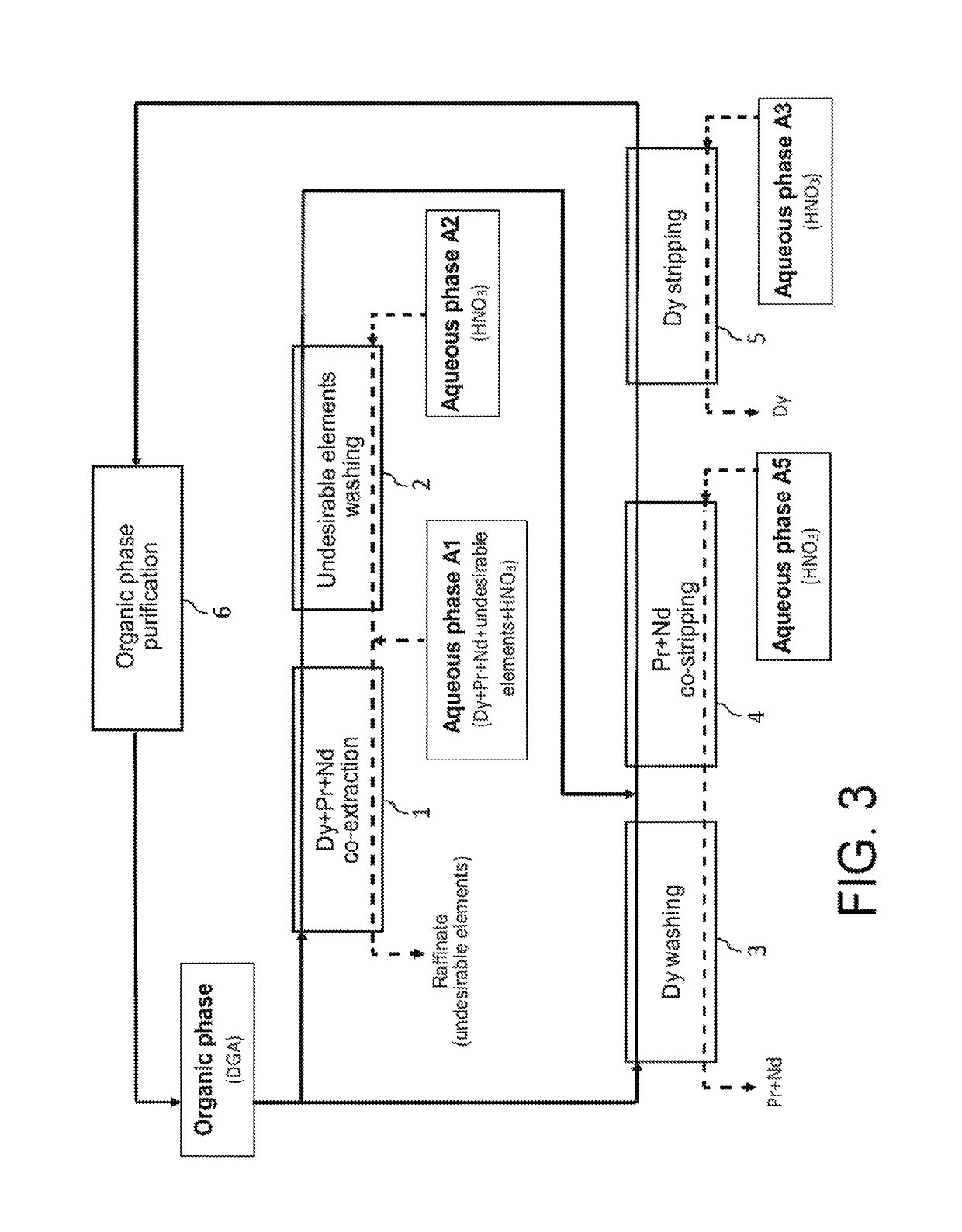Processes for selective recovery of rare earth metals present in acidic aqueous phases resulting from the treatment of spent or scrapped permanent magnets
a technology process, applied in the field of selective recovery of rare earth metals present in spent or scrapped permanent magnets, can solve the problems of not being able to adapt the use of extractants to the recovery generating supply risks of rare earth metals for the market, and not being very interesting industrially
- Summary
- Abstract
- Description
- Claims
- Application Information
AI Technical Summary
Benefits of technology
Problems solved by technology
Method used
Image
Examples
example 1
Scheme of a Preferred Embodiment of the First Method of the Invention
[0093]Reference is made to FIG. 1 which illustrates the principle of a preferred embodiment of the first method of the invention, designed for processing, at an industrial scale, a nitric aqueous phase stemming from the processing of spent or scrapped permanent magnets NdFeB, with view to selectively recovering dysprosium which is the most interesting economically one of the heavy rare earth metals present in this aqueous phase.
[0094]This aqueous phase is for example an aqueous phase stemming from the dissolution in a nitric medium, supplemented with an oxidizer, of a powder of permanent magnets NdFeB as obtained in the aforementioned reference [2].
[0095]Such an aqueous phase, which is designated hereafter and in FIG. 1 as “Aqueous phase A1”, may comprise, according to the type of magnets from which it was obtained and from conditions under which the powder of magnets was dissolved in a nitric medium: from 0.2 mol / ...
example 2
Scheme of a First Preferred Embodiment of the Second Method of the Invention
[0113]Now, reference is made to FIG. 2 which illustrates the principle of a first preferred embodiment of the second method of the invention, in which this method is designed for processing at an industrial scale, an acid aqueous phase A1 similar to the one treated in the Example 1 hereinbefore but with view to selectively recovering, not only the dysprosium but also the praseodymium and neodymium, and this, in two cycles, i.e.: a first cycle which aims at selectively recovering dysprosium present in the aqueous phase A1 and a second cycle which itself aims at selectively recovering praseodymium and neodymium present in the raffinate of the first cycle.
[0114]The first cycle comprises:[0115]a first step, designated as “Dy extraction” in FIG. 2, which aims at extracting dysprosium from the aqueous phase A1 by means of a first organic phase not miscible with water;[0116]a second step, designated as “Pr+Nd+undes...
example 3
Scheme of a Second Preferred Embodiment of the Second Method of the Invention
[0131]Reference is made now to FIG. 3 which illustrates the principle of a second preferred embodiment of the second method of the invention, wherein this method is also designed for selectively recovering and at an industrial scale dysprosium, praseodymium and neodymium from an acid aqueous phase A1 similar to the one processed in Example 1 hereinbefore but in a single cycle.
[0132]This cycle comprises:[0133]a first step, designated as “Dy+Pr+Nd co-extraction” in FIG. 3, which aims at co-extracting dysprosium, praseodymium and neodymium from the aqueous phase A1 by means of a first organic phase not miscible with water;[0134]a second step, designated as “Undesirable elements washing” in FIG. 3, which aims at washing the organic phase stemming from the “Dy+Pr+Nd co-extraction” by means of an acid aqueous phase A2 for removing from this organic phase the metal elements other than dysprosium, praseodymium and ...
PUM
| Property | Measurement | Unit |
|---|---|---|
| atomic number | aaaaa | aaaaa |
| atomic number | aaaaa | aaaaa |
| temperature | aaaaa | aaaaa |
Abstract
Description
Claims
Application Information
 Login to View More
Login to View More - R&D Engineer
- R&D Manager
- IP Professional
- Industry Leading Data Capabilities
- Powerful AI technology
- Patent DNA Extraction
Browse by: Latest US Patents, China's latest patents, Technical Efficacy Thesaurus, Application Domain, Technology Topic, Popular Technical Reports.
© 2024 PatSnap. All rights reserved.Legal|Privacy policy|Modern Slavery Act Transparency Statement|Sitemap|About US| Contact US: help@patsnap.com










